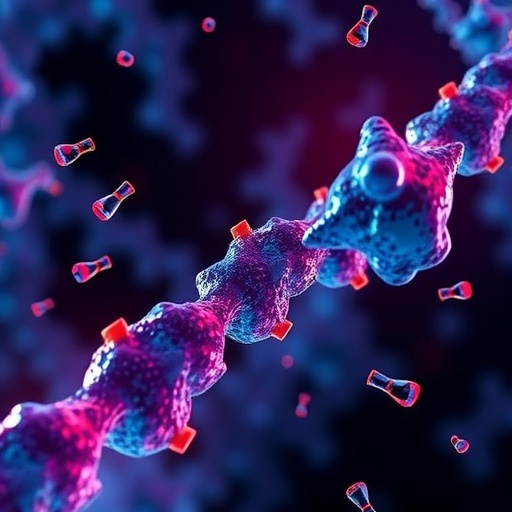In a groundbreaking advancement set to transform the landscape of drug discovery, researchers at Harvard Medical School have unveiled an innovative artificial intelligence (AI) model that can identify therapeutic interventions capable of reversing pathological states within cells. This pioneering tool, known as PDGrapher, revolutionizes traditional methodologies by targeting a network of disease drivers rather than isolated molecular targets, offering a sophisticated approach that discerns the genetic determinants most likely to restore healthy cellular function.
Unlike conventional drug discovery pipelines that typically focus on single protein targets tested individually for therapeutic efficacy, PDGrapher employs an integrated strategy that examines complex gene interactions and signaling pathways collectively implicated in disease progression. By capturing the multifaceted interplay of intracellular molecular networks, this AI-powered tool identifies optimal single or combination drug targets that have the potential to correct cellular dysfunction, significantly accelerating the path toward viable treatment options for challenging diseases.
At the core of PDGrapher’s methodology is a type of neural network architecture known as a graph neural network (GNN), which processes biological data by modeling the intricate web of relationships among various genes, proteins, and signaling cascades within the cell. This approach transcends simplistic, linear target identification by mapping causative effects and dependencies, thereby predicting which therapeutic modifications can effectively revert diseased cells to states of normal function. It shifts the paradigm from exhaustive compound screening to focused hypothesis generation about gene and protein targets with the highest likelihood of clinical impact.
PDGrapher operates by pinpointing cellular regions—clusters of genes or pathways—that contribute critically to disease phenotypes, followed by computational simulation of perturbations that modulate these regions. By virtually “switching off” or attenuating activity in these drivers, the model forecasts whether a cell’s diseased state would be reversed, thereby prioritizing drug candidates based on their potential to restore cellular health rather than merely inhibiting a single factor in isolation. This holistic treatment conceptualization mimics a seasoned chef’s precision in blending ingredients to achieve perfect balance rather than random culinary experimentation.
To validate the accuracy and utility of PDGrapher, the researchers trained the model using a diverse dataset comprising diseased cells both pre- and post-treatment, enabling it to learn patterns of genetic activity associated with remission and recovery. Subsequently, PDGrapher was challenged with 19 independent datasets spanning 11 distinct cancer types—many previously unseen during training—and tasked with predicting effective therapeutic targets. Impressively, it not only rediscovered known targets deliberately omitted during training to test genuine predictive power but also proposed novel candidates bolstered by emerging scientific evidence.
Among the prominent targets identified, PDGrapher highlighted KDR (also known as VEGFR2), a receptor tyrosine kinase implicated in angiogenesis, as an effective therapeutic node for non-small cell lung cancer (NSCLC). This aligns closely with clinical trials demonstrating the efficacy of VEGFR2 inhibitors. Similarly, the model surfaced TOP2A, an enzyme targeted by established chemotherapeutic agents, as a pivotal factor in certain tumor types, reinforcing recent preclinical research suggesting that inhibiting TOP2A can suppress metastatic dissemination in NSCLC.
Comparative analyses reveal that PDGrapher surpasses existing computational models in both predictive accuracy and runtime efficiency. In previously unseen datasets, it ranked correct therapeutic targets up to 35% higher than alternative AI methods and processed data up to 25 times faster. These performance metrics underscore its potential as a powerful tool to streamline the drug discovery pipeline, reducing costs and expediting translational research.
Crucially, PDGrapher’s causal modeling framework allows researchers to dissect the mechanistic underpinnings of combinatorial drug effects, shedding light on why certain target combinations yield synergistic therapeutic responses. By elucidating cause-effect relationships within complex biological networks, it facilitates a deeper understanding of disease biology and paves the way for more rational, mechanism-based therapeutic design.
This AI-driven approach holds particular promise for diseases characterized by multifactorial pathogenesis where single-target interventions often falter. Cancer typifies such complexity, as tumor cells frequently develop resistance to treatments that act on a solitary molecular pathway. PDGrapher’s capacity to identify multiple gene targets implicated in maintaining the malignant state enables the rational design of combination therapies capable of circumventing compensatory mechanisms within tumor cells.
Beyond oncology, the research team is extending PDGrapher’s utility to confront neurodegenerative disorders such as Parkinson’s and Alzheimer’s diseases. By analyzing cellular profiles and genetic determinants underlying aberrant neuronal function, the model aims to uncover therapeutic strategies that directly reverse pathological cellular processes. Collaborations with clinical centers, including the Center for XDP at Massachusetts General Hospital, are underway to identify drug targets relevant to rare inherited conditions like X-linked Dystonia-Parkinsonism, further highlighting the tool’s broad applicability.
Looking ahead, the researchers envision PDGrapher evolving towards personalized medicine applications, where it could analyze individual patient cellular profiles to tailor therapeutic combinations specifically targeted at a person’s unique disease biology. Such precision medicine approaches promise to enhance treatment efficacy and reduce adverse effects by moving away from “one size fits all” therapies toward custom-designed regimens informed by sophisticated computational models.
Funded by a broad consortium of federal agencies, philanthropic organizations, and industry partners, this work represents a collaborative triumph at the nexus of computational biology and clinical research. The team’s open-access release of PDGrapher invites the global scientific community to adopt and refine the platform, potentially catalyzing a new era in drug discovery that embraces complexity rather than shying away from it.
In summary, Harvard’s PDGrapher introduces a paradigm-shifting AI approach capable of predicting therapeutic targets that can reverse disease phenotypes at the cellular level by integrating causal biology and graph-based modeling. Its superior accuracy, speed, and capacity to elucidate combinatorial effects promise to accelerate the discovery of novel treatments for complex diseases, offering new hope for addressing some of medicine’s most intractable challenges.
Subject of Research: Not applicable
Article Title: Combinatorial prediction of therapeutic perturbations using causally-inspired neural networks
News Publication Date: 9-Sep-2025
Web References:
- PDGrapher GitHub: https://github.com/mims-harvard/PDGrapher
- Nature Biomedical Engineering Article: https://www.nature.com/articles/s41551-025-01481-x
References:
10.1038/s41551-025-01481-x
Keywords: Diseases and disorders




